HIGHLIGHTS: NOVEMBER 15, 2024
• JU student innovation competition
• Dairy ingredients seminar in the Philippines
• Comments needed on new FDA and APHIS fee hikes
• USDEC talks dairy trade expectations at NAFB
• USDEC at Gulfood Manufacturing
• Harden speaks on Chinese news network
• Member opportunity: Request space in USDEC pavilion at FoodEx 2025
• Member opportunity: Request space in USDEC pavilion at Food & Hotel Asia 2025
• Market Summary: Eyes on China
• China dairy farmers face challenging times
• East, Gulf Coast port labor talks restart, then halt again
• NZ voices concerns over potential Thai FTA dairy request
• Fonterra affirms consumer business sale, lifts farmgate price estimate
• Irish dairy company revamp: Kerry, Arrabawn, Tipperary
• Company news: Lifeway, Yoraour Biological Technology, Volac, Lakeview Farms
Featured
Dairy ingredients shine in Chinese student new product competition
The 6th Annual Jiangnan University (JU) Student Competition culminated on Oct. 26 with presentations of awards to a new crop of student-developed food and beverage products made with U.S. dairy ingredients. It was the last stage in a nearly seven-month undertaking that has significantly grown in prestige since the first contest in 2019.
“The competition has become an integral piece of the partnership between JU and USDEC,” said Annie Bienvenue, USDEC vice president, Global Ingredients Technical Marketing Services. “It is a very effective platform to deepen students' understanding of the characteristics of U.S. dairy ingredients, especially dairy proteins and dairy permeate, and their performance in different formulations. Participants come out of the competition with a high level of dairy ingredient knowledge that they can put into practice as they proceed in their careers—ultimately bolstering dairy demand.”
This year’s competition, themed “Dairy Ingredients Bring ‘New Productive Forces’ to Innovative Quality Foods,” kicked off in May with classroom training and coaching. In July, using the insights gained, 27 student teams delivered written proposals for new products showcasing dairy ingredients, including candies, biscuits, processed cheese, ice cream, yogurt, pastry, salad dressings and sauces. Judges evaluated the submissions and narrowed the field to 14 qualifiers.
The teams then had two-plus months to produce a prototype for sampling, develop packaging, prepare a video to promote their product and create a final presentation for the judging panel.
The videos were shared on WeChat in mid-October where viewers voted on their favorites. The sizable response generated by the videos is evidence of the broadening reach of the contest: online balloting jumped by 21% this year, representing nearly 30,000 additional votes than the 2023 contest.
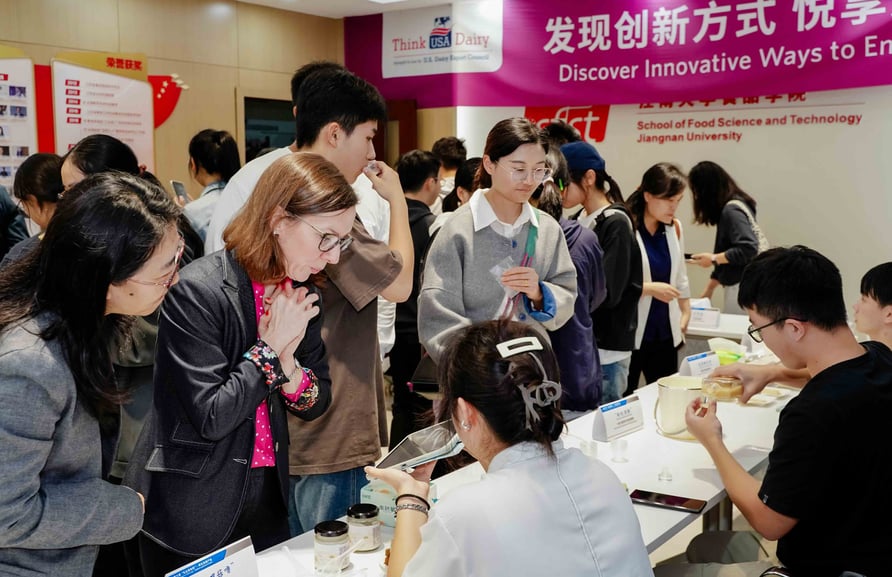
Judges, students and other attendees sample the competing products on Oct. 26, during the final day of the competition.
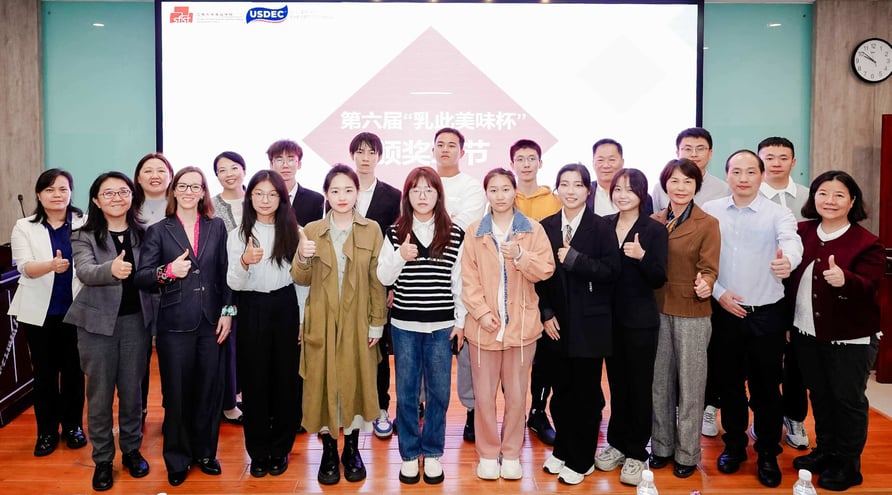
Representatives from the winning teams and the judging panel give a thumbs up to the 6th Annual Jiangnan University (JU) Student Competition to create innovative products focused on U.S. dairy ingredients.
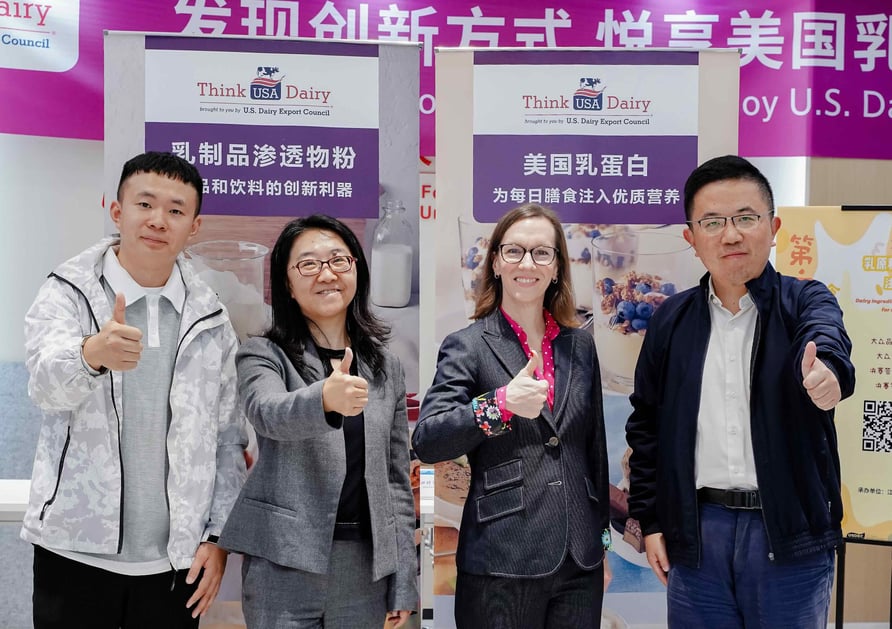
Left to right: Xinlei Wang, head of Science and Technology Innovation Competition, School of Food Science and Technology, JU; Professor Xiaoming Liu, vice director, Sino-U.S. Dairy Innovation Center, JU; USDEC’s Annie Bienvenue; and Lei Li, vice dean, School of Food Science and Technology, JU.
And the winners are …
The final round took place on Oct. 26. Each team gave its final presentation to a seasoned judging panel comprised of representatives from the food industry, and attendees sampled the entries.
The winning team created Keshig Yogurt-Flavored Compressed Biscuits. The product contains WPC80, WPI, whey permeate and milk powder. A photo of the biscuits is below, along with second and third places winners.
Other products garnered special awards, including “Most Creative” for Lime Green Snow Hibiscus Soft Cheese; “Best Taste” for Gouran Moo Moo Candy; and “Best Potential” for Rushan Yunnan Style Cheese.
“In addition to a growing audience, the competition is renowned at the university, especially in the School of Food Science and Technology,” says Bienvenue. “School leaders rate it highly, and it continues to attract more and more attention every year.”
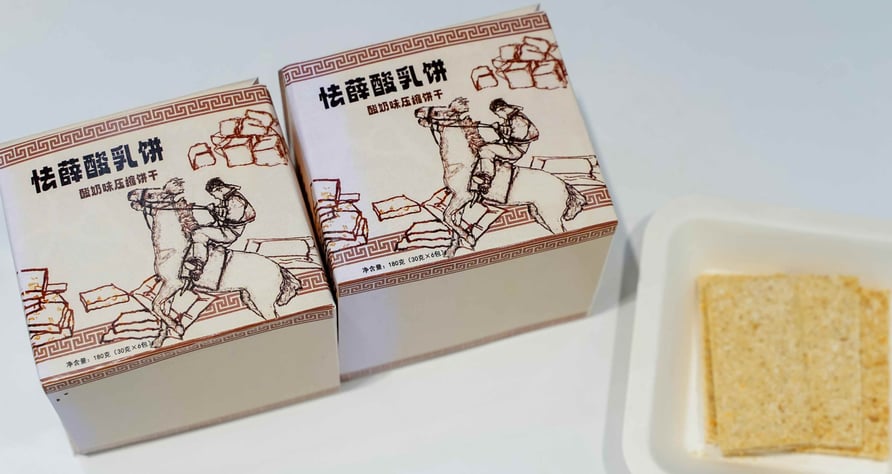
First place: Keshig Yogurt-Flavored Compressed Biscuits containing WPC80, WPI, whey permeate and milk powder.
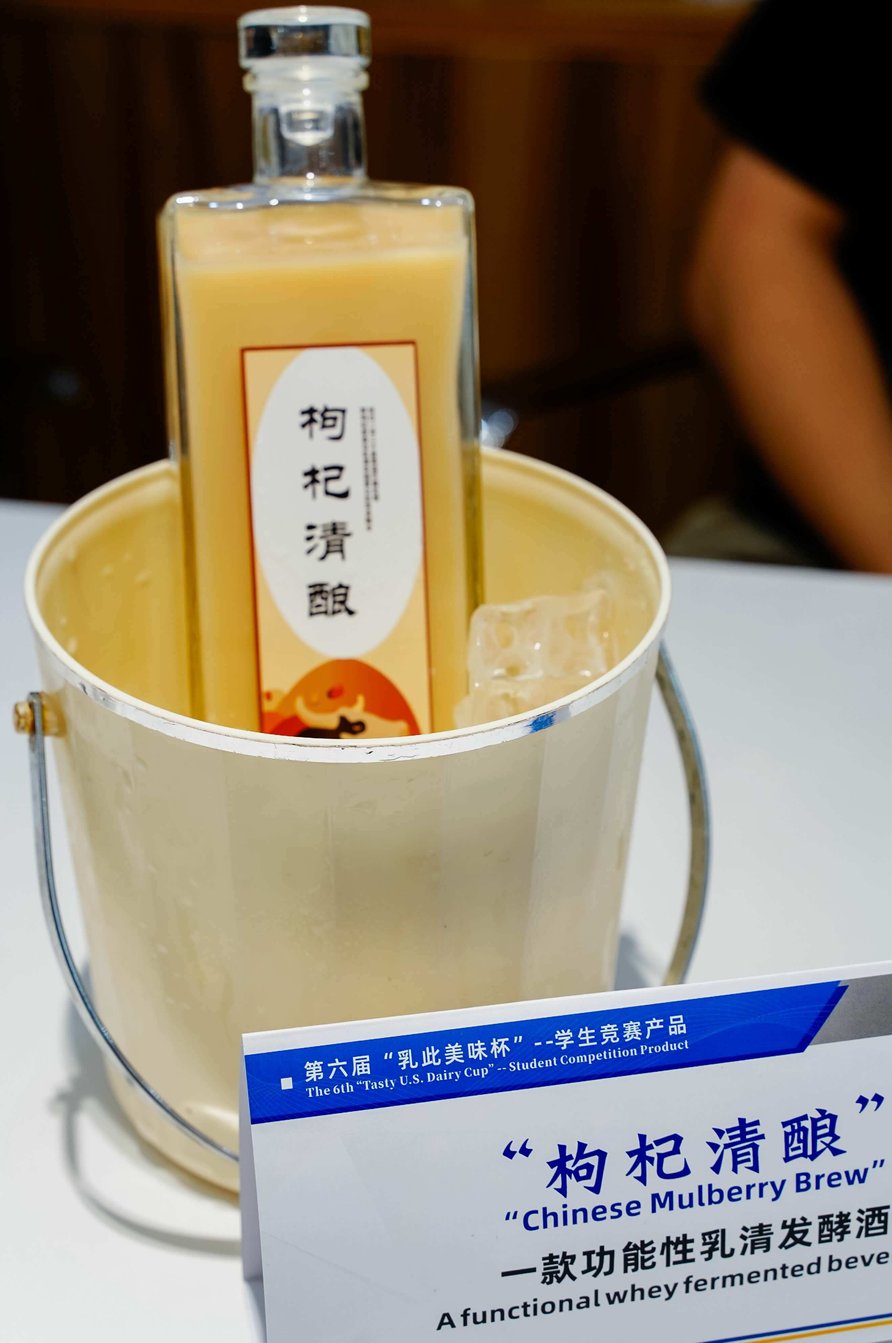

Two products tied for second place: Chinese Mulberry Brew (top), a functional fermented beverage featuring WPC80; and Jellygoo Creamy Mushroom Sauce (bottom), with WPC80, whey permeate and milk permeate.

Three products tied for third place, including Purenjoy Ice Cream (pictured above), which is made with WPC80, MPC and milk powder. The other two third-place winners were Earth Salad Dressing, containing WPC80 and whey permeate, and Kazi Kazi Crunch-Dipped Crispy Milk Biscuit, featuring WPC80, MPC, milk permeate and milk powder.
Philippine seminar shows how to innovate with U.S. dairy ingredients with an eye on convenient health and wellness products
USDEC held a comprehensive one-day dairy seminar in the Philippines to highlight how U.S. milk powder and other dairy ingredients can help Filipino families meet health and wellness goals. Ninety-nine Philippine food and beverage professionals attended the event, which took place Nov. 7 in Manila.
The Philippines is the largest U.S. dairy export market in Southeast Asia and the No.2 market globally for U.S. NFDM/SMP.
A lineup of expert speakers showcased U.S. dairy supply capacity, ingredient expertise and innovation capabilities to excite the local trade and build confidence in sourcing U.S. dairy ingredients. Highlights included:
- William Loux, USDEC senior vice president of Global Economic Affairs, outlined the substantial financial and physical investments the U.S. dairy community has been making in dairy protein and other dairy ingredient processing capacity. Those investments have the U.S. better positioned (vs. other origins) to supply dairy growth needs in the Philippines and globally. He also emphasized U.S. interest in serving the Southeast Asian market and his expectations that the region would be the fastest-growing export market for U.S. dairy in the years ahead.
- Anoo Pothen, director, Consumer Insights, USDEC Southeast Asia, reviewed a recent USDEC consumer study that highlighted a disconnect between dietary needs and consumption habits in the Philippines. Parents acknowledge the positive role of dairy in enhancing the nutritional value of packaged foods and beverages and the role balanced meals play in ensuring healthy children. But busier, time-constrained lifestyles complicate providing nutritious snacks and balanced meals.
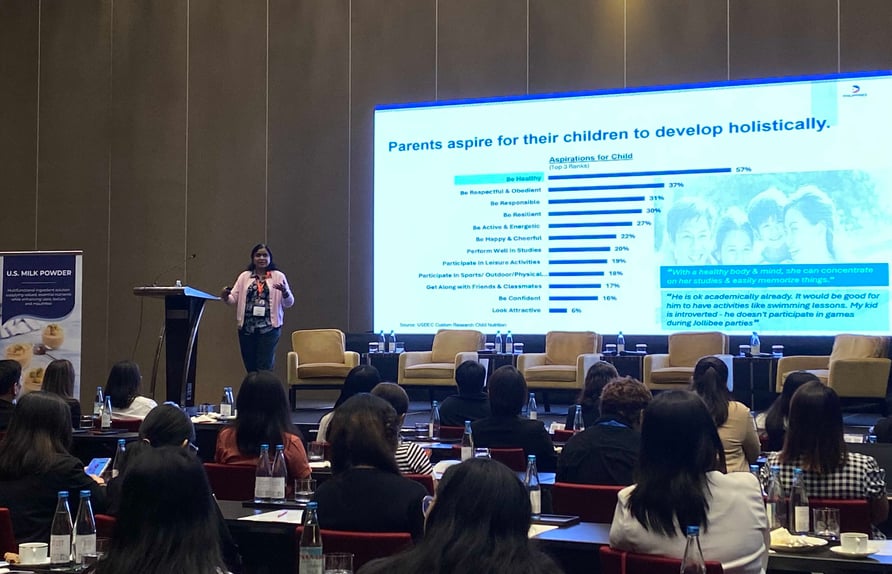
“Despite the recognition of the importance of balanced meals, many parents still struggle with providing their children nutritious snacks,” USDEC’s Anoo Pothen told the Filipino audience.
- Phil Tong, professor emeritus of dairy science at Cal Poly State University, outlined the similarities and differences between NFDM and SMP, including composition/functionality, applications and where they can and cannot be used interchangeably.
- Ryan Tay, associate professor, Singapore Institute of Technology, highlighted his collaborative research project with USDEC on optimizing high-protein Greek-style yogurt with U.S. MPC and NFDM/SMP. Tay found that both NFDM and SMP performed suitably in yogurt formulations in terms of physiochemical and sensory properties and adding MPC85 in higher protein yogurts can achieve taste and texture characteristics that match Southeast Asian consumer preferences.
- Martin Teo, senior director, Food Applications and Innovation, USDEC Southeast Asia, highlighted Philippine-friendly prototype ideas and reasons to innovate with U.S. dairy ingredients.
The seminar concluded with nearly two hours of 1-on-1 meetings between attendees and representatives from eight U.S. suppliers who attended the event.
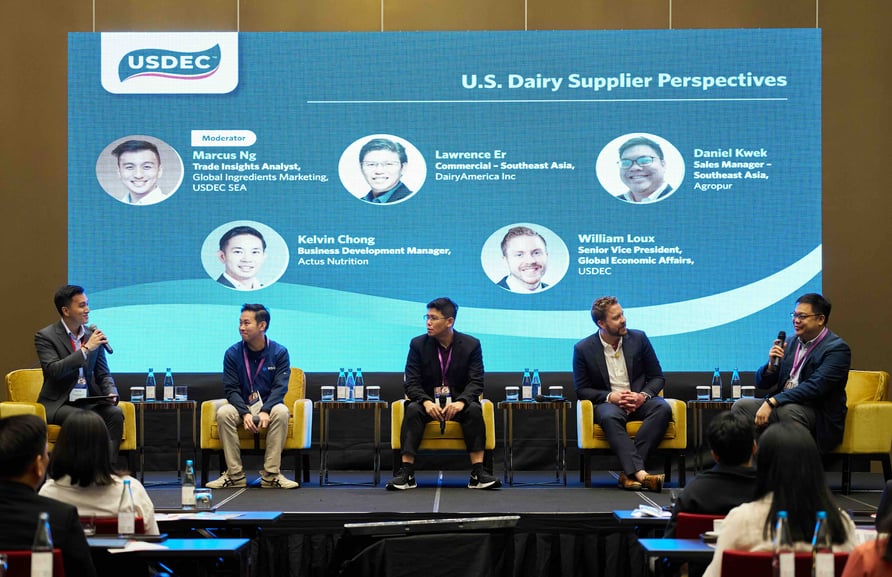
The U.S. dairy supplier panel reaffirmed U.S. dairy innovation capacity and commitment to support Filipino customers’ current and future supply needs.
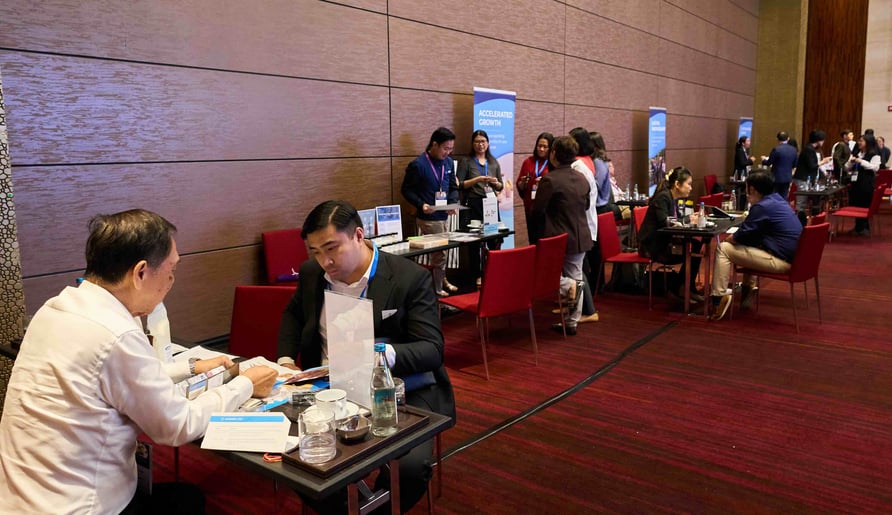
One-on-one meetings between U.S. dairy ingredient suppliers and seminar attendees capped the event.
USDEC requests member feedback on FDA and APHIS fee increase proposals
On Nov. 8, the U.S. Food and Drug Administration (FDA) and Animal and Plant Health Inspection Service (APHIS) issued Federal Register (FR) notices proposing significant new fees for their services.
- FDA is proposing to begin collecting a fee of $175 for plant registration for inclusion on the country plant lists it maintains (currently Chile, China, EU (and the UK), and India).
- APHIS is proposing to nearly double its fee for export certificates from $51 to $101 per certificate.
Both proposals are now open for comment. In addition to the opportunity for members to submit comments directly to both agencies, USDEC intends to file comments on behalf of members. See USDEC’s Nov. 14 Member Alert for more information on both proposals and the comment deadlines for members to share feedback with USDEC and to file directly with the respective agencies. Please contact Sandra Benson at sbenson@usdec.org with questions or for more information.
USDEC talks dairy export trade expectations at NAFB convention
USDEC’s Shawna Morris, executive vice president, Trade Policy and Global Affairs, shared U.S. dairy expectations for the upcoming year during a panel (and on the sidelines) at this week’s National Association of Farm Broadcasters (NAFB) annual convention in Kansas City.
During the panel, Morris and representatives from the U.S. Grains Council, U.S. Soybean Export Council and U.S. Meat Export Federation answered questions from the moderator and reporters throughout the room, commenting on everything from export market expectations to trade policy in the coming year. She also did agricultural press interviews on trade while there.
“While we’re quite likely to see upheaval in the coming year on the trade front, during the previous Trump Administration that turmoil did ultimately result in progress on certain trade areas, as we saw with the primarily non-tariff commitments in the U.S.-China Phase 1 deal and the tariff cuts in the U.S.-Japan Phase 1 agreement,” said Morris. “We will be identifying areas where market access gains are possible and needed and looking to work with the new administration to make headway on them.”
Harden airs on Chinese TV
China Global Television Network (CGTN), the English-language news channel of China’s state-run television news agency, aired a portion of its interview with USDEC President and CEO Krysta Harden. Harden sat with a CGTN reporter during a visit to China last week along with Jaime Castaneda, USDEC executive vice president, Policy and Strategy, for a series of dairy trade appearances and meetings with Chinese officials (see Global Dairy eBrief, 11/8/24). The interview focused on trade relations, sustainability and the future of dairy trade, further raising U.S. dairy’s profile in China.
U.S. dairy ingredients on display at Gulfood Manufacturing
An estimated 45,000 visitors attended this year’s Gulfood Manufacturing show in Dubai, marking a big jump in attendance from the estimated 25,000 that came for the 2023 edition. The show floor housed more than 2,500 exhibitors from 70 countries. Four USDEC member companies attended.
In 2024, the USDEC booth moved from the Ingredients Hall in past shows to the Dairy Hall. This gave U.S. dairy ingredients a strong presence directly alongside EU competitors and helped attract customers who are more focused on the dairy ingredients sector. Participation in the show served to strengthen the reputation of U.S. dairy ingredients in a marketplace that is increasingly competitive, as global dairy suppliers target rising demand in key Middle Eastern markets.
Key themes at the show (both on the floor and in educational sessions) included a focus on sustainability and technology-driven enhancements including advanced system monitoring technologies throughout the supply chain that are helping companies ensure safer operations.

Ady Abou Jaoude (center) from USDEC’s MENA office talks dairy ingredients with Gulfood Manufacturing attendees at the USDEC booth.
Events
Registration open for USDEC pavilion at Foodex Japan and Food & Hotel Asia 2025
USDEC will be hosting pavilions at two major 2025 trade shows targeting U.S. cheese suppliers: Foodex Japan and Food & Hotel Asia. Spots in the pavilions will be determined by a lottery system.
How the lottery works
Spot allocation will be determined by random lottery through a secure platform called Random Picker. Companies will be notified of the results shortly after the lottery.
Being awarded a lottery spot does not guarantee participation in the USDEC pavilion. All companies who are drawn in the lottery will be required to complete a copy of the USDEC Event Participation Agreement within one week of the lottery draw to confirm their participation, or their spot will be forfeited to another company.
FoodEx Japan 2025
FoodEx Japan 2025 takes place in Tokyo on March 11-14. The show, which will celebrate its 50th anniversary next year, attracted more than 75,000 visitors in 2024. USDEC has four booths available to members.
Members interested in participating in the USDEC pavilion must complete this form for the lottery draw by 5:00 p.m. ET on Thursday, Nov. 21. One entry per company. Members who do not complete the form by the deadline will only have their request for booth space considered after all members who filled out the form have been allocated a space or there is a cancellation.
Food & Hotel Asia (FHA) 2025
FHA 2025 takes place April 8-11 in Singapore. FHA is one of the largest food and beverage exhibitions in Asia. USDEC has eight booths available to members.
Members interested in participating in the USDEC pavilion must complete this form for the lottery draw by 5:00 p.m. ET on Monday, Nov. 26. One entry per company. Members who do not complete the form by the deadline will only have their request for booth space considered after all members who filled out the form have been allocated a space or there is a cancellation.
FHA 2025 participation fees are $5,200 for a corner booth or $5,000 for an interior booth. The fee will be nonrefundable as detailed in the USDEC Event Participation Agreement. USDEC will communicate details on exact booth locations after the lottery.
For questions on either show, please contact Nuhami Alemu at nalemu@usdec.org.
Market Summary
Eyes on China
Dairy supply and demand signals in China have been improving but remain inconsistent.
Chinese import data has done little to suggest that the country is poised for a demand rebound. Through three quarters, year-over-year imports were lagging the previous year by nearly 200,000 MT (major products, not including fluid). New Zealand September dairy exports, traditionally a precursor for following-month Chinese imports, show little to suggest a major turnaround is in the cards when October import data comes out next week. Apart from a 26% YOY increase in New Zealand cheese shipments to China in September and a 10% gain in butter, the numbers mostly pointed down.
At the same time, China’s domestic dairy supply continues to weaken. China’s milk production has fallen sharply in the second half of the year (-6.9% YOY for September) and milk powder inventories are reportedly low. (See story below for a report on how dairy farm profitability conditions have deteriorated.)
Preliminary data from Singles Day, the one-day celebration of single-hood that has evolved into a weekslong shopping extravaganza, is positive. The world's largest shopping event is considered a barometer for the Chinese economy and consumption. Chinese state media reported a 20%+ increase in sales this year, in line with reports from major Chinese retailers. While that's a positive sign, it remains too early to suggest it will lead to a dairy consumption surge.
Economists expected a highly anticipated meeting of China’s legislature last week might clarify new fiscal stimulus measures to support domestic consumption and give a jolt to the demand side. While the legislature approved a debt plan to bolster local governments, it did not reveal any new stimulus. Analysts believe China could be reserving further significant economic moves until it gets a better idea of the Trump Administration’s tariff plans.
AFP highlights Chinese dairy farm challenges
A recent Agence France-Presse (AFP) article on the state of China’s dairy industry paints a solemn picture of a dairy farmer crisis driven by several of the country’s current economic issues. Government efforts to import cattle and expand milk production capacity as part of its food self-sufficiency efforts have been followed by lower-than-expected consumption growth (due in part to pandemic fallout), leaving farmers with an excess of cows and milk. That, in turn, has led to more milk moving to the dryer and some farmers downsizing, either by selling cows to other farms or culling.
The article says China’s economic slowdown, declining birth rates and a shift in consumer preferences from premium products to experiences are all adding to the challenge for local dairy farmers, who say they have received little government support in response to the predicament. AFP also reports that the key to a turnaround lies in increasing consumer demand and consumption rates for dairy. (Agence France-Presse, 11/9/24)
Supply Chain
East, Gulf Coast labor talks restart, quickly break down
Renewed contract talks between the International Longshoremen’s Association and the U.S. Maritime Alliance (USMX) broke down almost immediately after they restarted this week. The two sides came to a tentative wage agreement prior to the presidential election, ending a brief strike (see Global Dairy eBrief, 10/4/24). They punted on other contentious issues like automation, instead extending the old contract until Jan. 15, 2025, while they continued talks.
The new talks stalled almost immediately when USMX proposed the use of semi-automated equipment at ILA-operated ports. The ILA characterized the proposal as an attempt to eliminate jobs. The USMX said the union is “insisting on an agreement that would move our industry backward by restricting future use of technology that has existed in some of our ports for nearly two decades.”
At press time, there was no word on future talks. (Bloomberg, 11/13/24; Wall Street Journal, 11/13/24)
Trade Policy
Thailand weighs approval process on NZ dairy exports
Thailand reportedly consulted with New Zealand to establish a process requiring approval from the Thai Milk Board before Kiwi dairy products receive tariff-free entry. The move comes as tariffs on New Zealand dairy are slated to come to an end on Jan. 1, 2025, when the dairy provisions of the NZ-Thailand Closer Economic Partnership (CEP) reach full maturity.
Dairy Companies Association of NZ (DCANZ) has raised concerns through the CEP’s formal submission process. “We await further updates on these proposals and if the intent for an approval from the Thai Milk Board is maintained, confirmation of what criteria would apply,” the group said. The New Zealand government said it is closely monitoring the situation and that it expects all trading partners, including Thailand to honor its trade obligations. (Farmers Weekly, 11/5/24)
Company News
Fonterra proceeds with consumer business sale, lifts FY25 forecast farmgate milk price
New Zealand-based Fonterra Co-operative Group confirmed it will sell its consumer business, which includes major brands like Anchor and Mainland. CEO Miles Hurrell said the revised strategy is “in the best interests of the Co-op" and will enable Fonterra to prioritize its Ingredients and Foodservice businesses, and create a more focused and higher-performing entity. He said Fonterra has yet to decide whether the business will be sold through a direct trade sale, or through an initial public offering that would put the assets into a separate company. Hurrell said the businesses on the block have received “meaningful buyer interest,” although he did not name companies.
Fonterra also increased the midpoint of its milk price forecast for the 2024/25 season to NZ$9.50 per kg/MS from NZ$9.00. Hurrell attributed the improved outlook to strong demand for reference commodity products, which has helped to push prices up in recent Global Dairy Trade auctions. He noted the demand “has been seen out of China, where there are indications that domestic production is below expectations, and also in Africa, the Middle East and Southeast Asia.” (Company reports)
Kerry Group to sell dairy division to Kerry Co-Operative Creameries Ltd.
In a move to focus on its taste and nutrition solutions, Kerry Group plc announced it has agreed to sell Kerry Dairy Ireland to Kerry Co-Operative Creameries Ltd. The divestment is estimated to be worth €500 million (about US$531 million). Under the terms of the agreement, Kerry Group will initially retain a 30% stake in the dairy division, which includes Kerry’s consumer dairy and dairy ingredients businesses, with plans for the coop to take full ownership in phases until the entire acquisition is complete in 2035. The proposed transaction will be put to a shareholder vote next month. (Company reports)
Arrabawn and Tipperary confirm merger
In an effort to create a stronger entity within the Irish dairy industry, the boards of Arrabawn Co-operative Society Ltd. and Tipperary Co-operative Creamery Ltd. unanimously confirmed the joint decision to merge the two operations. The new co-op, which will be known as Arrabawn Tipperary Co-operative Society and will be a dairy and agri-trading co-operative, is subject to regulatory approval by entities, including Ireland’s Competition and Consumer Protection Commission. (Agriland, 11/7/24)
Mergers, acquisitions and joint ventures
The UK’s Competition and Markets Authority approved Denmark-based Arla Foods Ingredients’ acquisition of the whey nutrition business of U.K.-based dairy company Volac, which specializes in whey ingredients for sports nutrition (see Global Dairy eBrief, 4/26/24). … Campbell Soup Co. is selling its Noosa yogurt business to Ohio-based Lakeview Farms, a manufacturer of fresh dips, desserts and specialty products. (Company reports)
Company briefs
Illinois-based kefir and probiotic products manufacturer Lifeway Foods announced an expanded distribution agreement in the United Arab Emirates market. The company is expected to begin exporting its 32-ounce Lifeway Kefir, 8-ounce Lactose-Free Lifeway Kefir, ProBugs and farmer cheese before the end of this year. The products will be available in supermarkets and hypermarkets in Dubai and across the Emirates. … China’s Yoraour Biological Technology Corp. opened its new $17-million nutritional products plant in Yinchuan, China. The facility will manufacture freeze-dried bovine colostrum and other health products in powder and solid forms. … In an effort to grow market share in China, Fonterra is expanding its Foodservice offerings in the country with the launch of Anchor Easy Bakery Cream, a mid-tier UHT cream for bakeries. The mid-tier market is the fastest growing segment of China’s UHT cream market, the company says. … Outback Steakhouse parent company Bloomin’ Brands announced it is selling majority ownership in its Brazilian business to Brazil-based franchise operator Vinci Partners for $243 million. Under the terms of the deal, which Bloomin’ Brands said will help the steakhouse focus on domestic operations, Vinci will assume 67% ownership of the country’s 200-plus restaurants, while Florida-based Bloomin’ Brands will retain 33%. … Pennsylvania-based dessert maker Taylor Chip Cookie Co. announced it will build a new $12.5 million, 20,000-square-foot facility designed to expand its cookie manufacturing operation and add ice cream production capabilities. The company plans to add packaged cookies and ice cream pints to its current direct-to-consumer business. (USDEC Middle East/North Africa office; USDEC China office; Company reports; Restaurant Business, 11/8/24; Dairy Processing, 11/5/24)
In Case You Missed It...
U.S. Dairy Exporter Blog
Market analysis, research and news subscribe hereUSDEC Twitter feed
Follow us here.